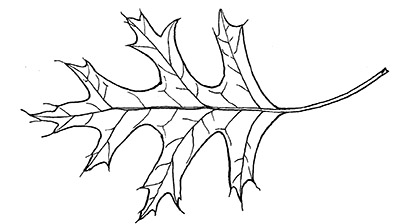Intro to Trees of Indiana: Pin Oak
The classic and trusted book "Fifty Common Trees of Indiana" by T.E. Shaw was published in 1956 as a user-friendly guide to local species. Nearly 70 years later, the publication has been updated through a joint effort by the Purdue Department of Forestry and Natural Resources, Indiana 4-H, and the Indiana Department of Natural Resources, and reintroduced as "An Introduction to Trees of Indiana."
A printed copy of the full publication is available for purchase for $7 in the Purdue Extension Education Store. The field guide helps identify common Indiana woodlot trees.
Each week, the Intro to Trees of Indiana web series will offer a sneak peek at one species from the book, paired with an ID That Tree video from Purdue Extension forester Lenny Farlee to help visualize each species as it stands in the woods. Threats to species health as well as also insight into the wood provided by the species, will be provided through additional resources as well as the Hardwoods of the Central Midwest exhibit of the Purdue Arboretum, if available. 
This week, we take a look at the eighth of our featured oak varieties in Indiana, the Pin Oak or Quercus palustris.
The leaves of pin oak are multi-lobed, with lobes coming out at nearly a 90-degree angle from the center of the leaves, and feature bristle tips like all members of the red/black oak family. On the pin oak, the alternately held leaves typically have less lobes than other members of the red/black oak group. In the fall, leaves change from medium green to a red to reddish brown color.
One key characteristic of pin oak are the branches, which angle downward especially on the lower part of the tree. The pin oak tends to keep its lower branches for a long period of time, which can create pin knots in the wood.
The trunk of pin oak is typically straight and single stemmed, while the bark is smooth and gray and may develop dark fissures with age.
The fruit is a rounded acorn with a relatively flat top with smooth scales, which covers only about one quarter of the nut.
quarter of the nut.
Pin oaks, which grow to 60 to 70 feet tall and are relatively fast growing, are found mostly in moist to wet areas, such as streams, lakes and other wetlands, oftentimes in soils that have a medium to high acidity. Pin oaks also have been planted in many sites for landscape purposes.
The natural range of the pin oak is in bottomlands and imperfectly drained soils from New Jersey south to Virginia and west to Eastern Kansas and Oklahoma as well as south into North Carolina, Tennessee and Arkansas.
The Morton Arboretum states that pin oak suffers greatly from chlorosis or yellowing of the leaves in soils with high pH. As with other oaks, the pin oak should be pruned in the dormant season to avoid attracting beetles that may carry oak wilt, which can be a potential disease problem along with oak blister.
According to the Hardwood Lumber and Veneer Series, red oak, which can contain as many as 17 different species of trees including black oak, constitutes about one third of all the hardwood lumber produced, with northern red oak as the most preferred species.
In general, red oak lumber has a very characteristic, showy, coarse grain pattern. Wood color can range from a vary light pink to a blood red color. Red oak is rated as the best wood to plane and second best in boring. It also receives high marks for shaping, turning and steam bending.
Lumber from the red oak group weighs around 44 pounds per cubic foot, making it one of our heavier woods. It is also one of our strongest woods. Red oak lumber has been used for a variety of purposes from furniture and cabinets to millwork, caskets and hardwood flooring.
Other Resources:
ID That Tree: Pin Oak
ID That Tree: Red Oak Group
Hardwood Lumber and Veneer Series: Red Oak Group
Morton Arboretum: Pin Oak
Purdue Plant Doctor
Native Trees of the Midwest, The Education Store
Shrubs and Woody Vines of Indiana and the Midwest, The Education Store
Investing in Indiana Woodlands, The Education Store
Forest Improvement Handbook, The Education Store
ID That Tree, Purdue Extension-Forestry & Natural Resources (FNR) YouTube playlist
Woodland Management Moment , Purdue Extension-FNR YouTube playlist






